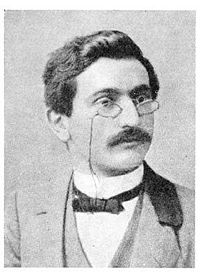Emanuel Lasker (24 December 1868 - 11 January 1941)

World Champion between 1894 and 1921, Lasker was the most successful player for many years to come. Despite losing the World title, he was still capable of winning several major tournaments, and he was considered one of the best players until his late sixties. His games have been exhaustively analysed and he has been accused of psyching his opponents during games. Lasker was the ideal chess fighter - eager to play, confident and profound.
Lasker was born in Berlinchen, Prussia. His first international successes were in
1889 in Germany, 1891 in England and
1893 in the United States. In 1894 he won the
World Championship by triumphing over Steinitz by the score of +10 -5 =4. This was followed by a string of tournament victories: St. Petersburg 1895/6,
Nuremberg 1896, London 1899 and
Paris 1900.
He then briefly returned to his studies in mathematics, where he received a doctorate in 1902, for research on abstract algebraic systems.
Lasker began his own chess magazine in 1904,
Lasker's Chess Magazine, which ran from 1904-1908. In 1904, he tied for second at
Cambridge Springs, whereas in 1909 he tied for first at St. Petersburg. In the years in between, Lasker defeated several rivals in matches.
Against Marshall in 1907, he won by the enormous margin of +8 -0 =7. In 1908, he
defeated Tarrasch +8 -3 =5, and in 1909 he
beat Janowski by +7 -1 =2. In 1910, he drew
against Schlechter +1 -1 =8. In
St. Petersburg 1914 Lasker showed his mettle when he overcame trailing the young Capablanca by 1.5 points. He demolished the young Cuban in their direct encounter. This notwithstanding, Capablanca got the better out of Lasker when he defeated him
in 1921 by the score of +4 -0 =10.
Lasker demanded large fees for his participation in tournaments. As a result, chess players of the day saw an improvement in their financial situation. Lasker returned to competitive play in 1923 where he was successful in various tournaments till about 1925.
Lasker now devoted himself to philosophy, where he was teaching and writing. He returned to competitive chess in 1934, at the age of sixty-six. Lasker died in New York on 11 January 1941. His complex play has inspired generations of chess players.